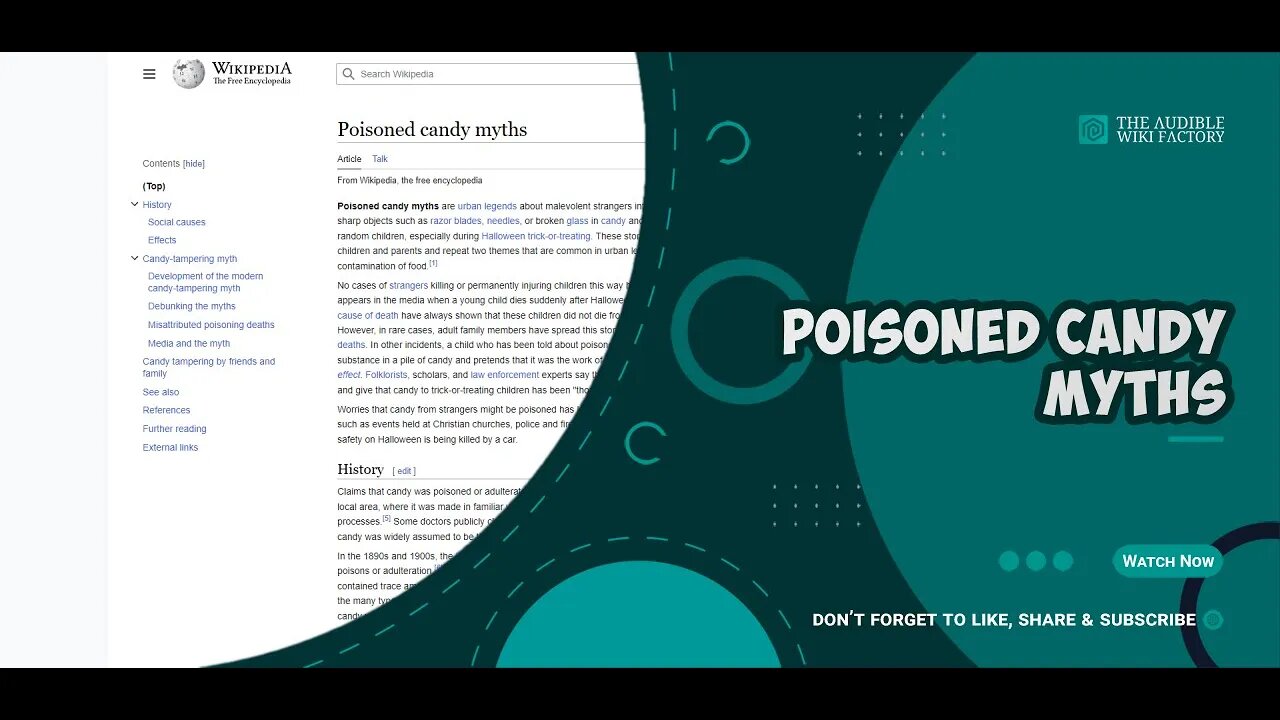Premium Only Content

Poisoned candy myths are urban legends about malevolent strangers intentionally hiding poisons,
Poisoned candy myths are urban legends about malevolent strangers intentionally hiding poisons, drugs, or sharp objects such as razor blades, needles, or broken glass in candy and distributing the candy in order to harm random children, especially during Halloween trick-or-treating. These stories serve as modern cautionary tales to children and parents and repeat two themes that are common in urban legends: danger to children and contamination of food.
No cases of strangers killing or permanently injuring children this way have been proven. Commonly, the story appears in the media when a young child dies suddenly after Halloween. Medical investigations into the actual cause of death have always shown that these children did not die from eating candy given to them by strangers. However, in rare cases, adult family members have spread this story in an effort to cover up murder or accidental deaths. In other incidents, a child who has been told about poisoned candy places a dangerous object or substance in a pile of candy and pretends that it was the work of a stranger. This behavior is called the copycat effect. Folklorists, scholars, and law enforcement experts say that the story that strangers put poison into candy and give that candy to trick-or-treating children has been "thoroughly debunked".
Worries that candy from strangers might be poisoned has led to the rise of alternative events to trick-or-treating, such as events held at Christian churches, police and fire stations, community centers, and retail stores. The primary risk to children's health and safety on Halloween is being killed by a car.
HISTORY
Claims that candy was poisoned or adulterated gained general credence during the Industrial Revolution, when food production moved out of the home or local area, where it was made in familiar ways by known and trusted people, to strangers using unknown ingredients and unfamiliar machines and processes. Some doctors publicly claimed that they were treating children poisoned by candy every day. If a child became ill, and had eaten candy, the candy was widely assumed to be the cause. However, no cases of illness or death were ever substantiated.
In the 1890s and 1900s, the US Bureau of Chemistry, in conjunction with state agencies, tested hundreds of kinds of candy and found no evidence of poisons or adulteration. These tests revealed that inexpensive glucose (from corn syrup) was in common use for cheap candies, that some candies contained trace amounts of copper from uncoated copper cooking pans, and that coal tar dyes were being used for coloring, but there was no evidence of the many types of poison, industrial waste, garbage, or other adulterants alleged to be present. Eventually, the claims that children were being sickened by candy were put down to indigestion due to overeating, or to other causes, including food poisoning due to improper cooking, hygiene, or storage of meat and other foods.
SOCIAL CAUSES
The prevalence and persistence of these myths during the 1960s and 1970s, a time of social upheaval, greater racial integration, and improved status for women, reflected societal questions about who was trustworthy. Because society was struggling with questions about whether to trust neighbors in newly integrated neighborhoods, or young women who were publicly rejecting the subservient, motherhood-focused roles previously assigned to women, these stories about unidentifiable neighbors allegedly harming random, innocent children during an event intended to bring happiness to these children caught and retained the public imagination in a way that accurate stories about a judgmental neighbor, an abusive parent, or an adult carelessly leaving harmful chemicals where children can reach them, would not have. An...
LINK TO ARTICLE: http://en.wikipedia.org/wiki/Poisoned_candy_myths
TAGS: Poisoned candy myths, Poisons, Halloween food, Death hoaxes, Candy
#GeneralKnowledge #AudibleWikiFactory #Audible #Wikipedia #Poisonedcandymyths
-
 34:34
34:34
The Audible Wiki Factory
2 years agoSaint Patrick's Day, or the Feast of Saint Patrick, is a religious and cultural holiday held on
801 -
 UPCOMING
UPCOMING
Sean Unpaved
30 minutes agoNo Respect for Hurts, Gillis Goes Wild, MLB Trade Deadline Buzz, & CFB's Big Question
-
 LIVE
LIVE
Donut Operator
1 hour agoCRIME/ CYCLISTS ARE SCUM/ GAMEBOY CAMERA CHAD
2,846 watching -
 LIVE
LIVE
Right Side Broadcasting Network
2 hours agoLIVE: White House Press Secretary Karoline Leavitt Holds a Press Briefing - 7/17/25
3,982 watching -
 10:51
10:51
Adam Does Movies
1 hour agoI Know What You Did Last Summer - Movie Review
801 -
 UPCOMING
UPCOMING
The Tom Renz Show
37 minutes agoThe DOJ Does Something! They Sue to Keep Fluoride in the Water???
12 -
 LIVE
LIVE
The Charlie Kirk Show
56 minutes agoDefund NPR + New War in Syria? America's Military Restored| Ashkar | 7.17.25
2,608 watching -
 LIVE
LIVE
Viss
56 minutes ago🔴LIVE - How to Win The Battleground with Tactics, Precision, & Knowledge!
110 watching -
 LIVE
LIVE
The Mel K Show
1 hour agoMORNINGS WITH MEL K - Redefining the Threat We Face: Who are our Allies and Adversaries Really? 7-17-25
938 watching -
 40:09
40:09
The Rubin Report
2 hours agoListen to ‘The View’ Crowd Gasp as Whoopi Melts Down Over Mark Cuban’s Mild Criticism of Dems
57.5K54